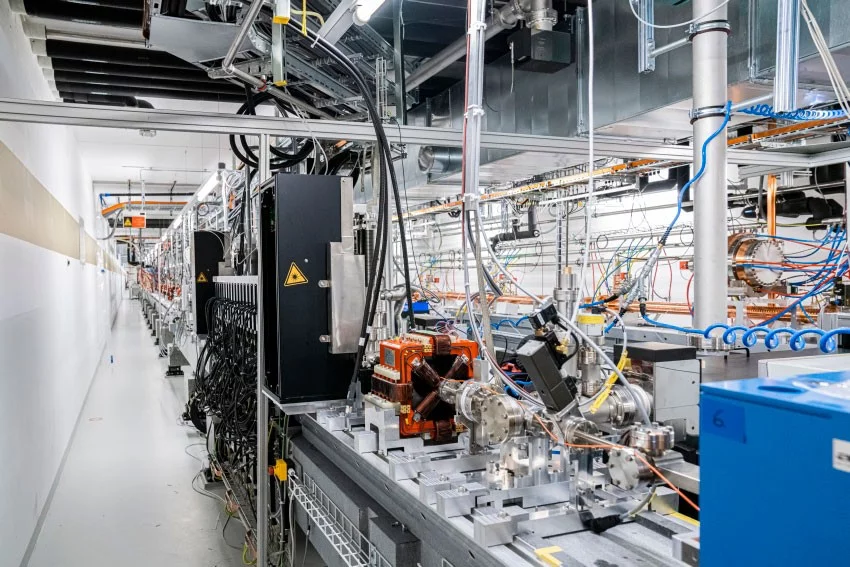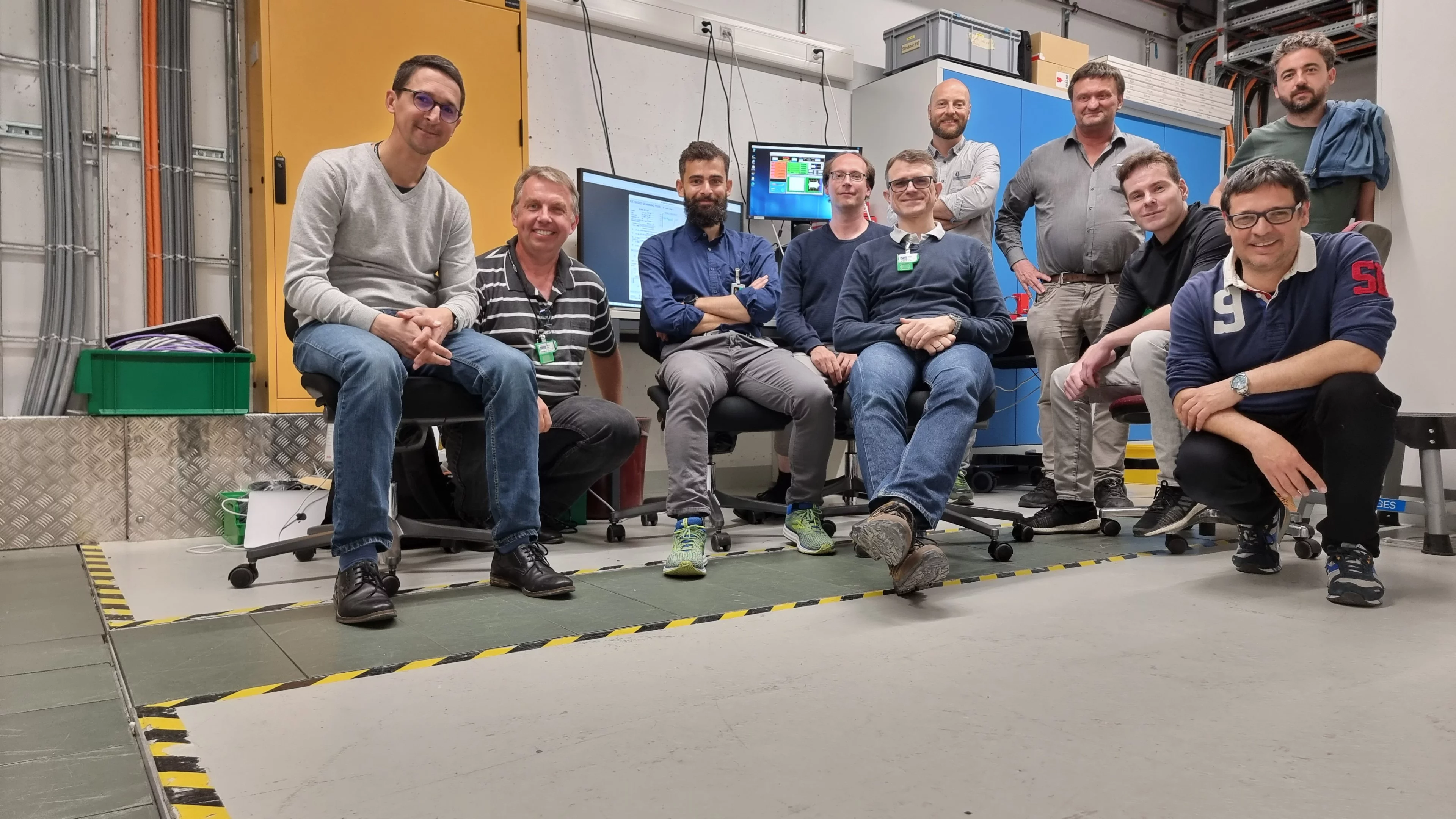An upgrade at the soft X-ray beamline of the free electron laser SwissFEL will open up new experimental capabilities. Using an external laser system to ‘seed’ the emission of X-ray photons, and thus imprint well-defined optical properties on the beam, the upgrade gives the Athos beamline unprecedented stability. With this, ultra-fast ‘attosecond’ timescales that probe the movements of electrons in chemical reactions become possible.
Free electron lasers (FELs) in the X-ray regime, such as the X-ray free electron laser SwissFEL, produce short pulses of brilliant light that give unique insights into the structure and dynamics of materials through so-called ‘molecular movies’. The Athos beamline of SwissFEL produces so-called ‘soft’ X-rays whose comparatively low photon energies are useful for studying the interactions between molecules.
A limitation for the Athos beamline, as for almost all FELs, is stability. The reason for this comes down to the process by which light is made: a process called self-amplified spontaneous emission (SASE). In a FEL, electrons, accelerated to close to the speed of the light, are wiggled by a series of magnets, called undulators. Once wiggling, they produce photons: at SwissFEL, in the form of X-rays. SASE describes the process by which these photons repeatedly interact with the electron beam and stimulate – or ‘seed’ – the emission of more photons in subsequent parts of the electron beam. The spontaneous emission of radiation in this way is a stochastic process. This means that the X-ray beam created is inherently unstable, characterised by variations in wavelength and pulse energy.
Thanks to funding from the European Research Council (ERC), a new upgrade of Athos tackles this fundamental challenge of X-ray FELs. The upgrade forms part of the HERO project, which in 2018 was awarded a prestigious Synergy grant of 14 million Euros and incorporates principal investigators from PSI, EPFL, ETHZ and Stockholm. Standing for ‘Hidden, Entangled and Resonating Orders’, the HERO project, which is coordinated by PSI, aims to uncover hidden quantum properties in materials that cannot be studied with existing methods. The HERO upgrade of the Athos beamline will enable such new insights.
“What is demonstrated here is the power of funding for blue-skies research that the ERC uniquely provides to associated countries,” states Gabriel Aeppli, head of the Photon Science Division at PSI, who is the coordinating principal investigator for the HERO project.
Bringing Athos in line
In a classroom, one particularly well-behaved child can serve as a role model for all the children. In a similar vein, at the Athos beamline, the upgrade uses an external laser to imprint its well-behaved properties on the FEL beam. Instead of relying on the stochastic, spontaneous emission of radiation, a ‘seed-laser’ interacts with the wiggling electron beam to amplify the emission of radiation. As this external, optical laser has a well-defined pulse and coherence properties, it can transfer these to the emitted X-rays.
There is a reason that an X-ray FEL has never before been externally seeded. “Although the principle of ‘seeding’ a FEL is not entirely new, seeding a FEL at an energy range as high as this is,” explains Alexandre Trisorio, head of the gun laser group, who developed the seed-laser system. “The trouble is that there are no external laser sources that operate in the right wavelength range”.
To get around this, the scientists – through some serious feats of electron bunch gymnastics and tricks of the light - are employing a technique known as echo-enabled high-harmonic generation (EEHG), whereby higher frequency resonances are created that seed the FEL. The full upgrade is a two phase project, the first of which has now been successfully completed.
From ultra-fast to even faster
Currently, SwissFEL produces ultra-fast pulses of light that last for a few femtoseconds (1 femtosecond = 0,000 000 000 000 001 seconds). The first phase of the upgrade, funded by the ERC HERO project, will provide pulses between 10 and 100 times shorter: attosecond pulses. This will enable new insights into chemical reactions, which are currently not well understood time-wise. “About 100 attoseconds corresponds to the fastest movement of an electron in an atom or molecule,” explains Sven Reiche, head of the FEL Beam Dynamics group. “If the pulse is shorter than this we can resolve the position of individual electrons”.
On an 11m long optical bench in a dedicated cleanroom conveniently located alongside the start of the Athos beamline, lies the complex seed-laser system. To achieve this first phase, the first of two titanium sapphire lasers have been installed. New hardware has also been installed in the accelerator tunnel: namely, a modulator in which the seed-laser and electron bunch interact, and a magnetic chicane to further manipulate the electron bunch.
About 100 attoseconds corresponds to the fastest movement of an electron in an atom or molecule. If the pulse is shorter than this we can resolve the position of individual electrons.
In May, the scientists successfully overlapped the laser beam with the electron bunch, demonstrating for the first time, externally seeded FEL emission in the soft X-ray energy regime. The team have now progressed to produce trains of attosecond pulses with a constant periodicity: that of the external seed laser. “This is an important milestone, which demonstrates that the first stage of the HERO upgrade is working. Now the fun starts: using this for the science”, says Romain Ganter, project leader for the accelerator section of Athos, happily.
From nearly clean to really clean
The second phase, financed by PSI, will complete the EEHG seeding scheme by installing the second seed-laser system, together with an additional modulator and magnetic chicane. This scheme will make sure that all the waves are in phase, and at its completion, Athos will be the first fully coherent soft X-ray FEL in the world. “In phase one, we cleaned up the FEL signal in the time domain. Now, we’re going to clean it up in the frequency domain,” explains Reiche. Having this type of control over the beam would be a game changer, enabling a range of exotic experiments that probe the interaction of intense, coherent X-ray beams with matter.
“This will be a huge advantage for users. Previously, as the central frequency was unstable, they had to use a monochromator to select the frequency – and by doing so throw away a huge number of photons. Now, they can get really stable signal without a monochromator. This means more signal and some tantalising opportunities to venture into nonlinear optics”, adds Reiche.
From versatile to even more versatile
From the word go, versatility has been a feature of the Athos beamline. The beamline has always boasted a unique degree of control over beam parameters. This is due to an accelerator set-up that sets it apart from other FELs worldwide: an alternating series of 16 undulators, interspersed with magnetic chicanes, which enable flexible manipulation of the electron beam while they produce the X-ray light. And it is thanks to this design – and the foresight of PSI accelerator scientists – that the upgrade is now possible.
“The most important decision was to have these small chicanes between the undulators,” reflects Reiche on the original design process of Athos in 2019, which he was heavily involved in. “Back then, we weren’t sure that HERO would be possible, but having this arrangement was high up the wish list. The undulator setup is something you can’t easily go back and change, but with it, all sorts of things become possible.”
The HERO upgrade will enhance Athos’ versatility further. It is not a mandatory feature, but rather an add-on that users can choose to use – or not use. “Once you have such a tool, it gives you flexibility”, explains Ganter. “It may take a little while for the users to work out how they can best exploit it. But once they do, I don’t think they will ever go back.”
Text: Paul Scherrer Institute / Miriam Arrell
© PSI provides image and/or video material free of charge for media coverage of the content of the above text. Use of this material for other purposes is not permitted. This also includes the transfer of the image and video material into databases as well as sale by third parties.



